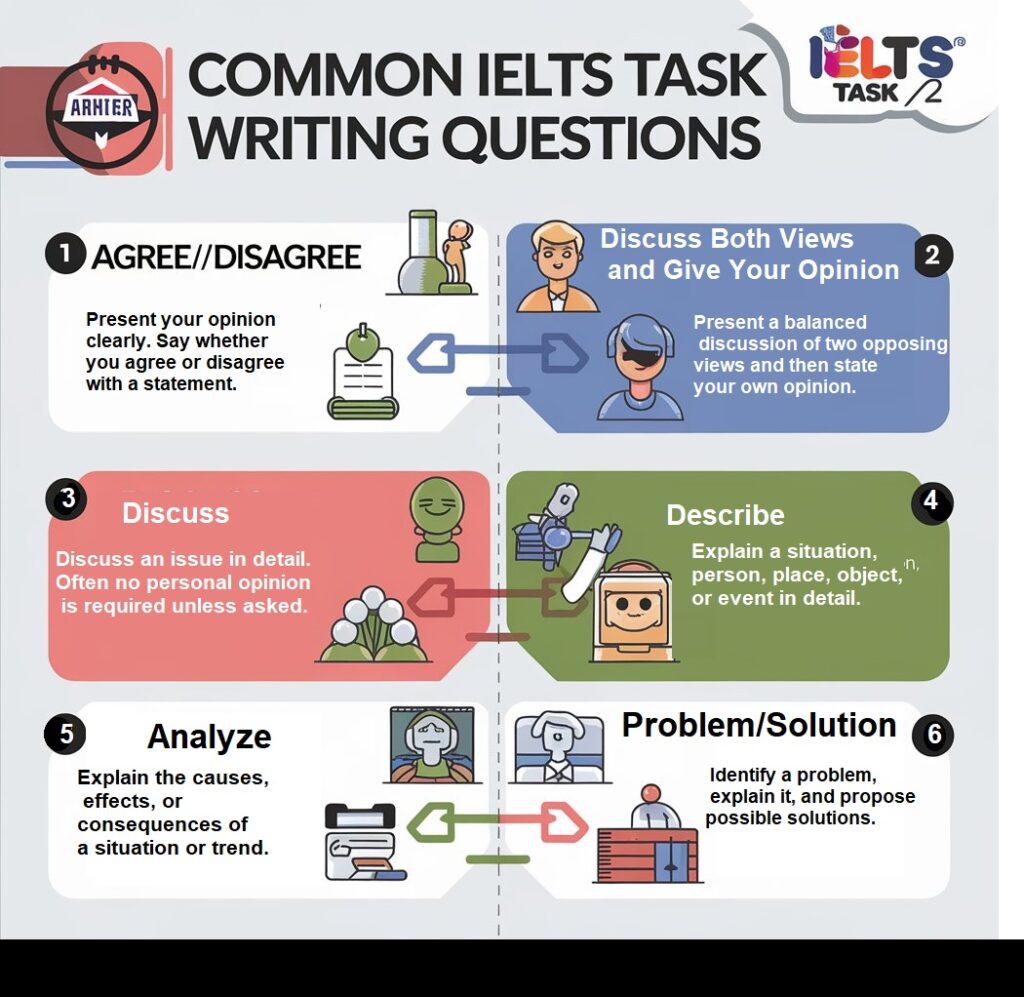If you’re preparing for the IELTS Task 2 writing, you’ve likely realized that success requires more than strong grammar and vocabulary. Strategy plays a crucial role. Knowing what types of questions to expect and how to respond to each can significantly impact your score.
We will explore the five most common questions you’ll likely encounter in IELTS Task 2 Writing. For each type, we’ll break down what it asks, how to structure your response, and offer practical tips to help you write with clarity, coherence, and
confidence.

Why Understand the IELTS Task 2 Writing Question
Type Matters
IELTS Task 2 Writing requires candidates to write a formal, academic-style essay of at least 250 words in response to a specific question. You are evaluated based on four main criteria:
One of the most common reasons candidates lose marks is misinterpreting the question. Each essay type requires a slightly different approach, and if you don’t recognize what’s being asked, you risk going off-topic. That’s why understanding these five common question types is essential.
Read this IELTS Writing Task 2 Essay Structure
1. Opinion Essay (Agree or Disagree)
Example:
Do you agree or disagree with the statement: “Technology has made our lives better”?
What It Asks
This type of question presents a statement and asks whether you agree or disagree with it. You may also partially agree if your opinion is clearly explained.
How to Approach
-
Introduce the topic and state your position clearly in the thesis statement.
-
Present 2–3 well-developed reasons to support your opinion in the body paragraphs.
-
Optionally, include a counterargument and refute it.
-
Conclude by restating your opinion and summarizing key points.
Avoid being indecisive. Choose a clear stance and support it with specific, relevant examples.
2. Advantages and Disadvantages Essay
Example:
What are the advantages and disadvantages of working from home?
What It Asks
You are asked to discuss the positive and negative sides of a particular issue or practice.
How to Approach
-
Start with an introduction that paraphrases the question.
-
Use one body paragraph to outline the advantages and another to explore the disadvantages.
-
Optionally, include your opinion in a third paragraph or the conclusion.
-
Summarize both sides and state a balanced view if required.
Ensure equal coverage of both aspects to avoid bias. Use transition words to signal shifts in perspective.
3. Problem and Solution Essay
Example:
Traffic congestion is a growing problem in many cities. What are the causes, and what can be done to solve this issue?
What It Asks
This question requires you to identify the causes of a particular problem and propose feasible solutions.
How to Approach
-
Begin by clearly defining the problem in the introduction.
-
Dedicate one paragraph to discussing the causes.
-
Use a second paragraph to propose and explain possible solutions.
-
Ensure that the solutions logically address the problems identified.
Think from economic, social, and political angles to make your arguments more comprehensive.
4. Discussion Essay (Discuss Both Views)
Example:
Some people believe children should learn history; others think it is useless. Discuss both views and give your opinion.
What It Asks:
This task asks you to present both sides of an argument before stating your view.
How to Approach:
-
Present one viewpoint in the first body paragraph and the opposing view in the second.
-
Use a third paragraph (or the conclusion) to explain your own perspective.
-
Maintain a respectful and objective tone while discussing both perspectives.
Even if you disagree with one view, ensure it is presented fairly and accurately before offering your critique.
5. Double Question Essay (Two-Part Question)
Example:
Why do people move to cities? What problems can this cause?
What It Asks
This type contains two distinct questions. Both must be addressed thoroughly and equally.
How to Approach:
-
Carefully read the question to identify both parts.
-
Introduce the topic and mention both questions in the introduction.
-
Write one body paragraph for each question.
-
Conclude with a summary of your answers and a final reflection if appropriate.
Do not treat one question as more important than the other. Allocate equal space and effort to both.
FAQ
Q1: Can I use personal examples in my essay?
Yes, but keep them general and academic. Avoid overly personal or emotional stories. Aim for examples that are relatable and relevant to a broader audience.
Q2: How many paragraphs should I write?
A standard structure includes four to five paragraphs: an introduction, two or three body paragraphs, and a conclusion.
Q3: How can I improve coherence in my writing?
Use linking phrases like “however,”” on the other hand, ” and “and, for example. Make sure each paragraph flows logically to the next.
Q4: Is it acceptable to partially agree in an opinion essay?
Yes, you can partially agree if you explain your position and support both sides appropriately.
Q5: What is the most common mistake in IELTS Writing Task 2?
Failing to understand the question type. Misinterpreting the prompt can lead to an off-topic response, significantly lowering your Task Response score.









 Evan John
Evan John